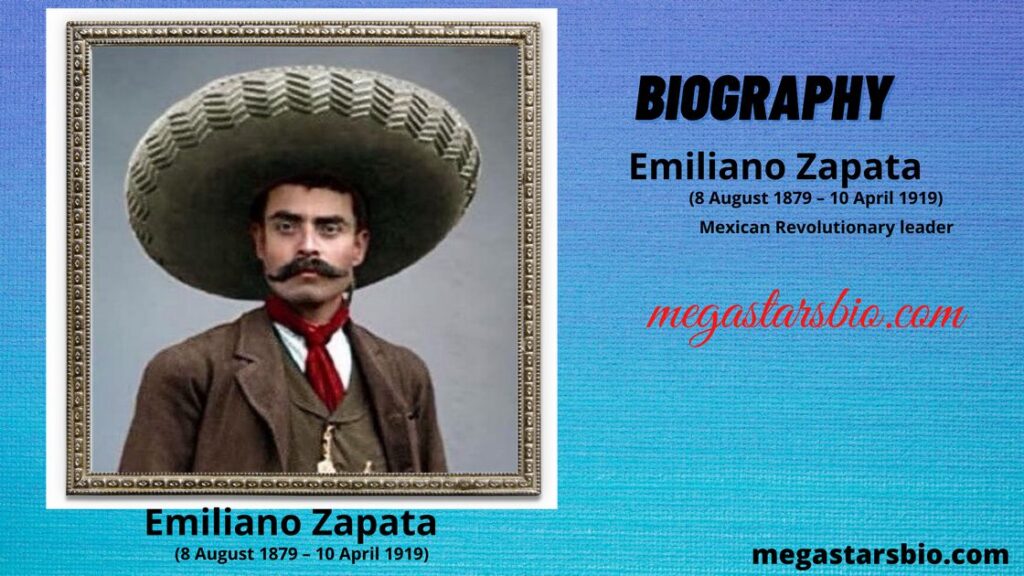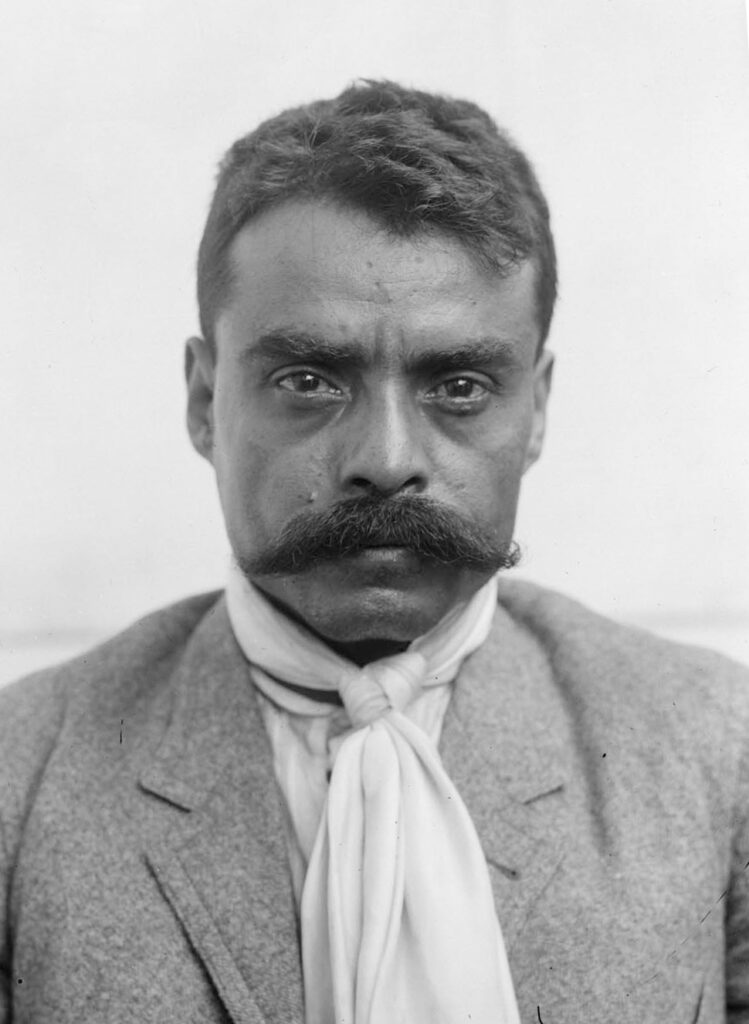Emiliano Zapata( 8 August 1879 – 10 April 1919), a Mexican revolutionist, was born in Anenecuilco, Morelos, in 1879 and was shot to death in Morelos on April 10, 1919. He was the penultimate 10 children of Cleofas Salazar and Gabriel Zapata, a mestizo Mexican farmer who trained horses. He was orphaned at 17 years of age and had to look after his younger Brothers and Sisters.
In the complex development of the Mexican Revolution of 1910, the so-called agrarian leaders took up the just aspirations of the poorest rural classes, who had been driven to misery by an arbitrary agrarian policy that dispossessed them of their lands. Of all of them, Emiliano Zapata is still the most admired.

Faced with the unscrupulous ambition or ideological inconsistency of Pancho Villa or Pascual Orozco, and faced with an idea of revolution more linked to the war for power than to social transformation, Emiliano Zapata remained faithful to his ideals of justice and gave absolute priority to effective achievements.
Unfortunately, that same firmness and constancy in the face of the confusing revolutionary winds determined his isolation in the state of Morelos, where he undertook fruitful reforms from a position of virtual independence that no government could tolerate. His assassination, instigated by the presidency, led to his work’s rapid dissolution and the exaltation of the leader, who would go down in history as one of the great revolutionary myths of the 20th century in Mexico.
| NAME | Emiliano Zapata |
| FULL NAME | Emiliano Zapata Salazar |
| SHORT NAME | Emiliano |
| Date of Birth | 8 August 1879 |
| BirthPlace | Anenecuilco |
| Nationality | Mexican |
| Religion | N/A |
| Died | 10 April 1919 |
| Best Known for | Mexican Revolutionary leader |
Biography of Emiliano Zapata
Table of Contents
Belonging from a humble peasant family member, he was the ninth of the ten children that Gabriel Zapata and Cleofás Salazar had, of which only four survived. There is no total agreement for his birth date; the most widely accepted is that of August 8, 1879, but his biographers point out several others: around 1877, 1873, around 1879, and 1883.
Emiliano Zapata worked as a laborer and sharecropper since he was a child and received a poor school education. He was orphaned around the age of Seventeen. Both he and his older brother Eufemio inherited a little land and a few heads of cattle, a legacy they had to support themselves and their two sisters, María de Jesús and María de la Luz.

Emiliano Zapata Family Member
| Father’s Name | Gabriel Zapata |
| Mother’s Name | |
| Brothers Name | Eufemio Zapata |
| Sisters’ Name | María de Jesús and María de la Luz |
His brother Eufemio sold his share of the inheritance and was a dealer, peddler, merchant, and various other things. Instead, Emiliano remained in his hometown, Anenecuilco, where he was a sharecropper on a small part of the land of a neighboring farm in addition to working his land. When work in the fields declined, he drove mule trains and traded with the animals his great passion: horses. When he was around seventeen years old, he had his first confrontation with the authorities, which forced him to leave the state of Morelos and to live for some months in hiding on the ranch of some friends of his family.
You can also read: Claudio Bravo Biography, Age, wiki, Family, Wife, Height & more
Nina Dobrev Instagram and Olga Ladyzhenskaya Biography
In his childhood, little Brave Emiliano Zapata showed special interest in Mexico’s history, especially Independence. Soon after, he was involved in the great Historical Mexican Revolution of 1910 and everything that had to do with the struggles that were taking place in the country.
According to his biography published on the various websites and Electronic Media hoses dedicated to the Bicentennial of the Mexican Independence and Centennial of the Revolution, in 1906, he came to a meeting in Cuautla proposed to defend the rights and lands of the peasants against the Porfirian regime.
In 1908 he joined the 9th Regiment destined for Cuernavaca. However, he only lasted six months as a soldier since Ignacio de la Torre (1866-1918) invited him to be a knight in Mexico City.
He was elected resident of the Anenecuilco land defense board on September 12, 1909, a position from which he was in contact with Ricardo Flores Magón (1873-1922), with the journalist Paulino Martínez and with Professor Otilio Montaño (1887-1917).
In support of the opposition candidate Patricio Leyva, Zapata had his first political intervention in the election for governor of Morelos the same year, which brought reprisals for Anenecuilco since the winner was the official candidate Pablo Escandón (1856-1926).
A year later, supported by José A. Vivanco’s (1899-1979) political leader, the Ombudsman dedicated himself to recovering by force the lands taken from the Villa Ayala peasants’ plots for cultivation among them.
Motivated by the San Luis Plan’s agrarian demands, he joined the Maderista army at the Revolution outbreak. Still, once Madero triumphed, the lands’ distribution was not carried out, so Zapata responded by taking Cuautla, Yautepec, and Cuernavaca.
On November 25, 1911, Zapata promulgated the Plan de Ayala, with which he took up arms against the government of Francisco I. Madero (1873-1913) was in disagreement concerning the agrarian question.
In 1915, after Villa’s defeat, numerous forces were directed throughout Morelos to hunt down Zapata, since only Zapatismo remained as an obstacle to the consolidation of the new government.
Brave Zapata was betrayed and murdered by Colonel Jesús Guajardo (1892-1920). On April 10, 1919, at the Chinameca hacienda; his body was taken to Anenecuilco and later transferred to Cuautla, where his remains rest at the foot of the statue erected to him.
Also Read: Qui était Chalino Sanchez et comment est-il mort ?
Emiliano Zapata courageously defended the property of the land; the phrase “Land and Freedom” could synthesize the wishes of the peasants who even today continue to acclaim, “The land is for those who work it.“
Out of many reasons, one of the causes of the Mexican Revolution in1910 leads to was the disastrous agrarian policy developed by the Porfirio Díaz regime, whose long dictatorship gave its name to a whole period in the contemporary history of Mexico: the Porfiriato (1876-1911). Under the dictator’s iniquitous laws, landowners and large companies seized communal lands and small properties, leaving humble peasants dispossessed or displaced to almost sterile areas. It is estimated that in 1910, the year of the outbreak of the Revolution, more than ninety percent of the peasants lacked land and that around a thousand landowners employed three million braceros.
Such a policy condemned the rural population to misery. Although it was endemic throughout the country, it was severe in Morelos, where large landowners extended their sugar cane plantations at the expense of indigenous people and poor peasants. In 1909, a new real estate law threatened to make matters worse. In September of the same year, around four hundred inhabitants of Zapata, Anenecuilco, were summoned to a clandestine meeting to deal with the problem; it was decided to renew the municipal Emiliano Zapata was elected as president of the new council.
He was then thirty years old and had considerable charisma among his neighbors for his moderation and self-confidence; He happened to be the best horse trainer in the region, and many estates disputed him. As president of the council, Zapata began to deal with capital lawyers to enforce his countrymen’s property rights; Such activity did not go unnoticed, and possibly because of it, the army called him up. After a month and a half in Cuernavaca, he obtained a license to work as a groom in Mexico City, a job in which he remained for a short time.
Back in Morelos, Emiliano Zapata took up the defense of the communal lands. In Anenecuilco, a dispute had begun with the Hospital estate, and the peasants could not sow on the disputed lands until the courts resolved it. Emiliano Zapata made his first drastic decision: at the head of a small armed group, he occupied the Hospital’s lands and distributed them among the peasants. The daring action had resonance in the nearby towns since similar situations occurred everywhere; Zapata was appointed head of the Board of Villa de Ayala, a town that was the head of the district to which his hometown belonged.
People also ask
Why is Emiliano Zapata important?
Emiliano Zapata was a legendary Mexican revolutionist who fought for the Mexican Revolution. He fought for Mexica and adopted guerrilla action to stop injustice to the farmer. He had formed a commanded a liberation Army of the south, and since then, his followers were known as Zapatists.
What was Emiliano Zapata famous quote?
His famous quote is – ‘It is better to die on your feet than to live on your knees.
Why is Emiliano Zapata a hero?
Patriotic Emiliano Zapata fought for the common people and farmers of Mexico for land injustice. He is Hero because he leads the protest and builds an army brigade. He was brave to show the strength of the common people creating unity and building a brigade. He fought against Carranza and tried to demolish the power of Carranza from Mexico. Greedy Carranza wanted to rule Mexico, and he wanted to be rich and powerful and exploit Mexican farmers, snatching their own land.
Who assassinated Emiliano Zapata?
Emiliano Zapata was assassinated by agents of Venustiano Carranza, Mexico’s president and an opponent of Zapata’s land reform agenda.
Who said it better to die on your feet?
It’s a famous Emiliano Zapata quote – “It is better to die on your feet than to live on your knees.”
Who is Emiliano’s wife?
Josefa Espejo











